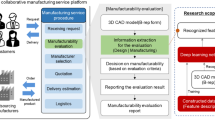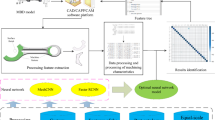Abstract
In machining feature recognition, geometric elements generated in a three-dimensional computer-aided design model are identified. This technique is used in manufacturability evaluation, process planning, and tool path generation. Here, we propose a method of recognizing 16 types of machining features using descriptors, often used in shape-based part retrieval studies. The base face is selected for each feature type, and descriptors express the base face’s minimum, maximum, and equal conditions. Furthermore, the similarity in the three conditions between the descriptors extracted from the target face and those from the base face is calculated. If the similarity is greater than or equal to the threshold, the target face is determined as the base face of the feature. Machining feature recognition tests were conducted for two test cases using the proposed method, and all machining features included in the test cases were successfully recognized. Moreover, we have compared the proposed method with the latest artificial neural network for test cases 3 and 4. As a result, the proposed method demonstrated a significantly higher recognition performance, with F1 scores of 0.94 and 1.0 for test cases 3 and 4, respectively, compared to the latest artificial neural networks (each with F1 scores of 0.86 and 0.49).




















Similar content being viewed by others
Availability of data and materials
Not applicable.
References
Yeo, C., Cheon, S., & Mun, D. (2021). Manufacturability evaluation of parts using descriptor-based machining feature recognition. International Journal of Computer Integrated Manufacturing, 34(11), 1196–1222. https://doi.org/10.1080/0951192X.2021.1963483.
Campana, G., & Mele, M. (2020). An application to Stereolithography of a feature recognition algorithm for manufacturability evaluation. Journal of Intelligent Manufacturing, 31(1), 199–214. https://doi.org/10.1007/s10845-018-1441-8.
Li, Y. G., Ding, Y. F., Mou, W. P., & Guo, H. (2010). Feature recognition technology for aircraft structural parts based on a holistic attribute adjacency graph. Proceedings of the Institution of Mechanical Engineers Part B Journal of Engineering Manufacture, 224(2), 271–278. https://doi.org/10.1243/09544054JEM1634
Yan, H., Yan, C., Yan, P., Hu, Y., & Liu, S. (2023). Manufacturing feature recognition method based on graph and minimum non-intersection feature volume suppression. The International Journal of Advanced Manufacturing Technology, 5, 1–20. https://doi.org/10.1007/s00170-023-11031-x
Kim, B. C., & Mun, D. (2014). Stepwise volume decomposition for the modification of B-rep models. The International Journal of Advanced Manufacturing Technology, 75(9), 1393–1403. https://doi.org/10.1007/s00170-014-6210-z.
Zubair, A. F., & Abu Mansor, M. S. (2020). Auto-recognition and part model complexity quantification of regular-freeform revolved surfaces through delta volume generations. Engineering With Computers, 36(2), 511–526. https://doi.org/10.1007/s00366-019-00710-7.
Kataraki, P. S., & Abu Mansor, M. S. (2017). Auto-recognition and generation of material removal volume for regular form surface and its volumetric features using volume decomposition method. The International Journal of Advanced Manufacturing Technology, 90, 1479–1506. https://doi.org/10.1007/s00170-016-9394-6.
Kim, B. C., & Mun, D. (2015). Enhanced volume decomposition minimizing overlapping volumes for the recognition of design features. Journal of Mechanical Science and Technology, 29(12), 5289–5298. https://doi.org/10.1007/s12206-015-1131-9.
Kwon, S., Mun, D., Kim, B. C., Han, S., & Suh, H. W. (2019). B-rep model simplification using selective and iterative volume decomposition to obtain finer multi-resolution models. Computer-Aided Design, 112, 23–34. https://doi.org/10.1016/j.cad.2019.03.003.
Woo, Y. (2003). Fast cell-based decomposition and applications to solid modeling. Computer-Aided Design, 35(11), 969–977. https://doi.org/10.1016/S0010-4485(02)00144-6.
Vandenbrande, J. H., & Requicha, A. A. (1993). Spatial reasoning for the automatic recognition of machinable features in solid models. IEEE Transactions on Pattern Analysis and Machine Intelligence, 15(12), 1269–1285. https://doi.org/10.1109/34.250845.
Jong, W. R., Lai, P. J., Chen, Y. W., & Ting, Y. H. (2015). Automatic process planning of mold components with integration of feature recognition and group technology. The International Journal of Advanced Manufacturing Technology, 78, 807–824. https://doi.org/10.1007/s00170-014-6627-4.
Li, Y. G., Ding, Y. F., Mou, W. P., & Guo, H. (2010). Feature recognition technology for aircraft structural parts based on a holistic attribute adjacency graph. Proceedings of the Institution of Mechanical Engineers, Part B: Journal of Engineering Manufacture, 224(2), 271–278. https://doi.org/10.1243/09544054JEM1634
Li, H., et al. (2015). Hint-based generic shape feature recognition from three-dimensional B-rep models. Advances in Mechanical Engineering, 7(4), 1687814015582082. https://doi.org/10.1177/1687814015582082.
Verma, A., & Rajotia, S. (2008). A hint-based machining feature recognition system for 2.5 D parts. International journal of production research, 46(6), 1515–1537. https://doi.org/10.1080/00207540600919373.
Ranjan, R., et al. (2005). Automatic recognition of machining features from a solid model using the 2D feature pattern. The International Journal of Advanced Manufacturing Technology, 26(7), 861–869. https://doi.org/10.1007/s00170-003-2059-2.
Hong, T., Lee, K., & Kim, S. (2006). Similarity comparison of mechanical parts to reuse existing designs. Computer-Aided Design, 38(9), 973–984. https://doi.org/10.1016/j.cad.2006.05.004.
Ohbuchi, R., & Furuya, T. (2009). Scale-weighted dense bag of visual features for 3D model retrieval from a partial view 3D model. In 2009 IEEE 12th international conference on computer vision workshops, ICCV workshops, IEEE (pp. 63–70). https://doi.org/10.1109/ICCVW.2009.5457716
Liu, Y. J., et al. (2013). User-adaptive sketch-based 3-D CAD model retrieval. IEEE Transactions on Automation Science and Engineering, 10(3), 783–795. https://doi.org/10.1109/TASE.2012.2228481.
Sánchez-Cruz, H., & Bribiesca, E. (2003). A method of optimum transformation of 3D objects used as a measure of shape dissimilarity. Image and Vision Computing, 21(12), 1027–1036. https://doi.org/10.1016/S0262-8856(03)00119-7.
Zehtaban, L., Elazhary, O., & Roller, D. (2016). A framework for similarity recognition of CAD models. Journal of Computational Design and Engineering, 3(3), 274–285. https://doi.org/10.1016/j.jcde.2016.04.002.
Sunil, V., Agarwal, R., & Pande, S. (2010). An approach to recognize interacting features from B-Rep CAD models of prismatic machined parts using a hybrid (graph and rule based) technique. Computers in Industry, 61(7), 686–701. https://doi.org/10.1016/j.compind.2010.03.011.
Guo, L., et al. (2021). A hybrid 3D feature recognition method based on rule and graph. International Journal of Computer Integrated Manufacturing, 34(3), 257–281. https://doi.org/10.1080/0951192X.2020.1858507.
Kim, S. W., Kong, J. H., Lee, S. W., & Lee, S. (2022). Recent advances of artificial intelligence in manufacturing industrial sectors: A review. International Journal of Precision Engineering and Manufacturing, 6, 1–19. https://doi.org/10.1007/s12541-021-00600-3
Jian, C., et al. (2018). An improved NBA-based STEP design intention feature recognition. Future Generation Computer Systems, 88, 357–362. https://doi.org/10.1016/j.future.2018.05.033.
Zhang, D., et al. (2020). Pointwise geometric and semantic learning network on 3D point clouds. Integrated Computer-Aided Engineering, 27(1), 57–75. https://doi.org/10.3233/ICA-190608.
Lee, H., et al. (2022). Dataset and method for deep learning-based reconstruction of 3D CAD models containing machining features for mechanical parts. Journal of Computational Design and Engineering, 9(1), 114–127. https://doi.org/10.1093/jcde/qwab072.
Zhang, Z., Jaiswal, P., & Rai, R. (2018). Featurenet: Machining feature recognition based on 3d convolution neural network. Computer-Aided Design, 101, 12–22. https://doi.org/10.1016/j.cad.2018.03.006.
Shi, P., et al. (2020). A novel learning-based feature recognition method using multiple sectional view representation. Journal of Intelligent Manufacturing, 31(5), 1291–1309. https://doi.org/10.1007/s10845-020-01533-w.
Peddireddy, D., et al. (2020). Deep learning based approach for identifying conventional machining processes from CAD data. Procedia Manufacturing, 48, 915–925. https://doi.org/10.1016/j.promfg.2020.05.130.
Yeo, C., et al. (2021). Machining feature recognition based on deep neural networks to support tight integration with 3D CAD systems. Scientific reports, 11(1), 1–20. https://doi.org/10.1038/s41598-021-01313-3.
Kim, H., et al. (2020). Deep-learning-based retrieval of piping component catalogs for plant 3D CAD model reconstruction. Computers in Industry, 123, 103320. https://doi.org/10.1016/j.compind.2020.103320.
Colligan, A. R., et al. (2022). Hierarchical CADNet: Learning from B-Reps for Machining Feature Recognition. Computer-Aided Design, 147, 103226. https://doi.org/10.1016/j.cad.2022.103226.
Colligan, R. T., Nolan, A. R., Hua, D. C., Cao, Y. W., & MFCAD + + Dataset (2022). Retrieved October 1, 2022, from https://doi.org/10.17034/d1fec5a0-8c10-4630-b02e-b92dc81df823
Shi, P., et al. (2020). Intersecting machining feature localization and recognition via single shot multibox detector. IEEE Transactions on Industrial Informatics, 17(5), 3292–3302. https://doi.org/10.1109/TII.2020.3030620.
Gerbino, S. (2003). Tools for the interoperability among CAD systems. In Proceedings of XIII ADM-XV INGEGRAF international conferences tools and methods evolution in engineering design
OpenCASCADE, & Open Cascade Technology. (2022). Retrieved May 1, from http://www.opencascade.com
DFMPro, H. C. L. (2022). Technologies Ltd. Retrieved May 1, https://dfmpro.com
Gupta, M. K., Swain, A. K., & Jain, P. K. (2019). A novel approach to recognize interacting features for manufacturability evaluation of prismatic parts with orthogonal features. The International Journal of Advanced Manufacturing Technology, 105(1), 343–373. https://doi.org/10.1007/s00170-019-04073-7.
Han, J., Pratt, M., & Regli, W. C. (2000). Manufacturing feature recognition from solid models: A status report. IEEE transactions on robotics and automation, 16(6), 782–796. https://doi.org/10.1109/70.897789.
Ning, F., et al. (2020). Manufacturing cost estimation based on the machining process and deep-learning method. Journal of Manufacturing Systems, 56, 11–22. https://doi.org/10.1016/j.jmsy.2020.04.011.
Wang, Q., & Yu, X. (2014). Ontology based automatic feature recognition framework. Computers in Industry, 65(7), 1041–1052. https://doi.org/10.1016/j.compind.2014.04.004.
Zhang, Y., et al. (2017). Semantic approach to the automatic recognition of machining features. The International Journal of Advanced Manufacturing Technology, 89(1), 417–437. https://doi.org/10.1007/s00170-016-9056-8.
Lim, S., Yeo, C., & Mun, D. (2022). Dataset of 3D CAD models used for descriptor-based machining feature recognition, Retrieved October 7, 2022. From https://www.dhmun.net/home/Research_Data.
Acknowledgements
This research was supported by the Basic Science Research Program [No. NRF-2022R1A2C2005879] through the National Research Foundation of Korea (NRF) funded by the Korean government (MSIT), by the Carbon Reduction Model Linked Digital Engineering Design Technology Development Program [No. RS-2022-00143813] funded by the Korean government (MOTIE), and by Institute of Information & communications Technology Planning & evaluation (IITP) grant funded by the Korea government (MSIT) [No.2022-0-00969].
Author information
Authors and Affiliations
Contributions
SL: Methodology, Data Curation, Software, Writing - Original Draft. CY: Data Curation, Software, Writing - Original Draft. FH: Resources, Writing – Review & Editing. JL: Methodology, Validation, Investigation, Writing - Review & Editing DM: Supervision, Conceptualization, Methodology, Writing - Review & Editing, Funding.
Corresponding authors
Ethics declarations
Ethics approval and consent to participate
This manuscript has not been published or presented elsewhere in part or in entirety and is not under consideration by another journal. Not applicable.
Consent for publication
Not applicable.
Competing interests
The authors declare no potential conflicts of interest with respect to the research, authorship, and publication of this article.
Additional information
Publisher’s Note
Springer Nature remains neutral with regard to jurisdictional claims in published maps and institutional affiliations.
Rights and permissions
Springer Nature or its licensor (e.g. a society or other partner) holds exclusive rights to this article under a publishing agreement with the author(s) or other rightsholder(s); author self-archiving of the accepted manuscript version of this article is solely governed by the terms of such publishing agreement and applicable law.
About this article
Cite this article
Lim, S., Yeo, C., He, F. et al. Machining Feature Recognition Using Descriptors with Range Constraints for Mechanical 3D Models. Int. J. Precis. Eng. Manuf. 24, 1865–1888 (2023). https://doi.org/10.1007/s12541-023-00836-1
Received:
Revised:
Accepted:
Published:
Issue Date:
DOI: https://doi.org/10.1007/s12541-023-00836-1




